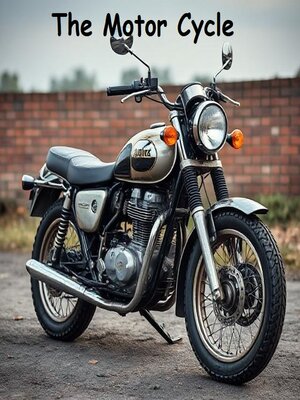
Sign up to save your library
With an OverDrive account, you can save your favorite libraries for at-a-glance information about availability. Find out more about OverDrive accounts.
Find this title in Libby, the library reading app by OverDrive.



Search for a digital library with this title
Title found at these libraries:
| Library Name | Distance |
|---|---|
| Loading... |
The history of the motorcycle dates back to the second half of the 19th century, evolving from bicycles into high-speed, powerful machines that revolutionized transportation and leisure. Here's a breakdown of its development:
1. The Birth of Motorcycles (1860s–1900s)
The first motorcycle-like vehicle was developed in 1867 by Pierre Michaux and his son Ernest in France. It was a steam-powered bicycle.
In 1885, German inventors Gottlieb Daimler and Wilhelm Maybach created the Daimler Reitwagen, the first internal combustion-powered motorcycle.
By the late 1890s, multiple inventors in the U.S. and Europe were experimenting with motorized bicycles.
2. The Rise of Motorcycle Companies (1900s–1930s)
The early 20th century saw the formation of some of the most iconic motorcycle brands:
1901: Indian Motorcycle Company (USA)
1903: Harley-Davidson (USA)
1902: Triumph (UK)
1904: Royal Enfield (UK)
Motorcycles were used in World War I (1914-1918) for reconnaissance and dispatching messages.
3. Innovation and Racing (1920s–1950s)
Improvements in engine power, speed, and reliability made motorcycles more practical and popular.
BMW introduced the shaft-driven motorcycle in the 1920s.
After World War II, motorcycles became an affordable transportation option for many.
4. The Rise of Japanese Manufacturers (1950s–1970s)
The 1950s and 1960s saw the dominance of Japanese manufacturers like:
Honda
Yamaha
Kawasaki
Suzuki
Honda's Super Cub (1958) became one of the best-selling motorcycles ever.
Japanese motorcycles gained a reputation for reliability and affordability, pushing many Western brands out of business.
5. Modern Superbike Era (1980s–2000s)
The 1970s and 1980s saw the birth of the modern superbike, with high-performance models like:
Honda CB750 (1969)
Kawasaki Z1 (1972)
Ducati 916 (1994)
Motorcycle racing, including MotoGP and Superbike Championships, grew in popularity.
6. Today's Motorcycle Industry (2010s–Present)
Electric motorcycles from companies like Zero Motorcycles, Harley-Davidson (LiveWire), and Tesla-concept models are gaining traction.
Autonomous and AI-powered motorcycles are being developed.
Adventure, touring, and cruiser motorcycles remain popular, with brands like BMW, KTM, and Triumph leading in their respective categories.
Conclusion
From early steam-powered bicycles to high-tech, electric superbikes, motorcycles have come a long way. They remain an essential mode of transportation, a symbol of freedom, and an adrenaline-fueled sport worldwide.







